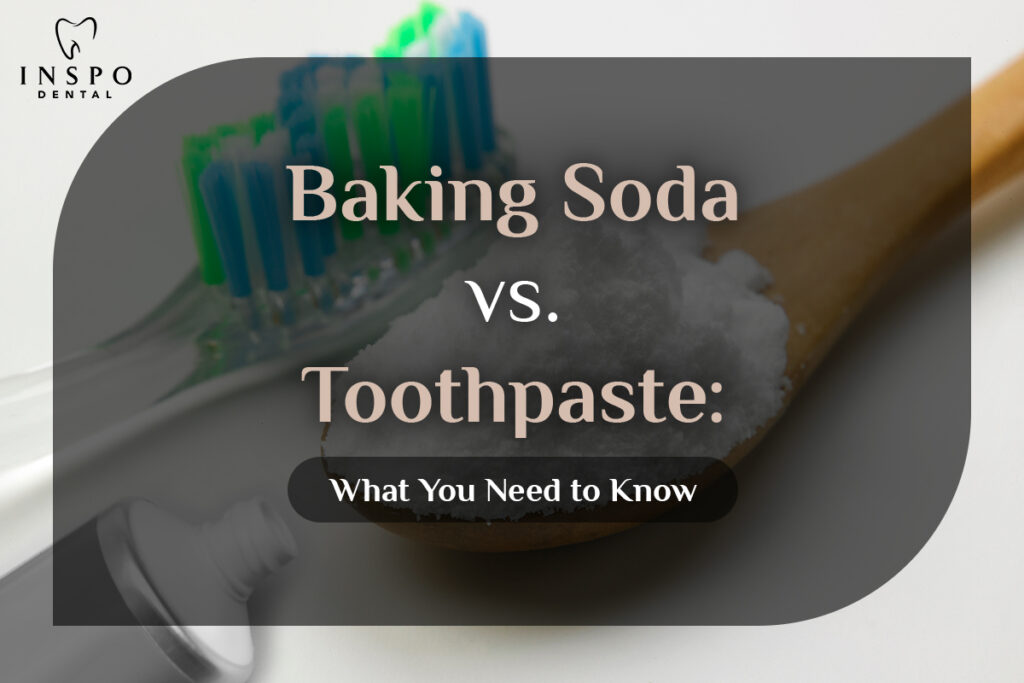Baking soda and toothpaste are both popular options for maintaining oral hygiene, but they serve slightly different purposes and have distinct properties. Here’s a breakdown of their differences, benefits, and potential drawbacks:
Baking Soda
What It Is:
Baking soda, or sodium bicarbonate, is a mild abrasive that has been used for centuries for cleaning purposes, including dental care.
Benefits:
- Mild Abrasive: Baking soda helps remove surface stains on teeth, making it an effective whitening agent.
- Neutralizes Acids: It helps neutralize acids in the mouth, which can reduce the risk of cavities and freshen breath.
- Inexpensive and Natural: It’s an affordable and natural alternative to commercial toothpaste.
Drawbacks:
- Limited Fluoride: Baking soda does not contain fluoride, an essential mineral that helps strengthen enamel and prevent tooth decay.
- Taste and Texture: It has a salty and gritty texture that some people find unpleasant.
- Potential Abrasiveness: Overuse can wear down enamel due to its abrasive nature, especially if used aggressively.
Best For: Occasional use as a stain remover or as an alternative for those who prefer natural products without added chemicals.
Toothpaste
What It Is:
Toothpaste is a formulated gel or paste that usually contains a combination of abrasives, fluoride, flavoring agents, and other ingredients to promote oral health.
Benefits:
- Contains Fluoride: Most toothpaste contains fluoride, which helps prevent tooth decay and strengthens enamel.
- Balanced Abrasiveness: Formulated to clean teeth effectively without excessive wear on enamel.
- Freshens Breath: Comes in various flavors and often includes ingredients to freshen breath.
- Anti-Bacterial Ingredients: Some toothpaste formulas include antibacterial agents to fight gum disease.
Drawbacks:
- Chemical Ingredients: Some toothpastes contain artificial ingredients, preservatives, and potential allergens.
- Cost: Can be more expensive compared to using baking soda alone.
- Environmental Concerns: Some toothpaste brands use microplastics and other ingredients that are harmful to the environment.
Best For: Daily use to maintain oral hygiene, prevent cavities, and keep breath fresh. Fluoride toothpaste is recommended by most dental professionals.
Which Should You Use?
- Daily Use: Regular fluoride toothpaste is generally recommended for everyday brushing due to its comprehensive benefits for oral health, including cavity prevention.
- Occasional Use of Baking Soda: Baking soda can be used occasionally for extra whitening or when seeking a natural alternative. However, it shouldn’t replace fluoride toothpaste entirely unless recommended by a dentist.
Combining Baking Soda with Toothpaste
Some people choose to combine baking soda with their regular toothpaste for enhanced whitening effects and a deeper clean. Here are some things to consider if you decide to mix the two:
Benefits of Combining:
- Enhanced Stain Removal: The mild abrasiveness of baking soda combined with the fluoride in toothpaste can help remove surface stains more effectively while still providing protection against cavities.
- Balanced Cleaning: Mixing baking soda with toothpaste can help balance the gritty texture and salty taste of baking soda while still leveraging its whitening properties.
- Improved Breath Freshening: Baking soda neutralizes odors, while toothpaste often contains flavoring agents that leave your mouth feeling fresh.
How to Combine:
- Use a pea-sized amount of toothpaste and sprinkle a small pinch of baking soda on top.
- Brush gently in circular motions to avoid excessive enamel wear.
- Limit this combination to a few times a week to avoid potential damage to the enamel.
Precautions When Using Baking Soda on Teeth
While baking soda is generally safe for occasional use, there are a few precautions to keep in mind:
- Avoid Overuse: Brushing with baking soda too frequently can lead to enamel erosion over time due to its abrasive properties.
- Gentle Brushing: Always use a soft-bristled toothbrush and gentle circular motions to minimize the risk of damaging your teeth or gums.
- Consult Your Dentist: If you have sensitive teeth, gum disease, or dental restorations like crowns or veneers, consult with your dentist before using baking soda as part of your oral care routine.
Special Considerations for Certain Conditions
- Sensitive Teeth:
Baking soda can be too abrasive for people with sensitive teeth. Opt for toothpaste specifically designed for sensitivity, as these are formulated to provide gentle cleaning while reducing sensitivity. - Dental Restorations (Crowns, Veneers, etc.):
Baking soda may scratch the surfaces of dental restorations. Stick to non-abrasive toothpaste that is safe for all dental work. - Gum Health:
If you have gum disease or are prone to gum recession, consult with your dentist before using baking soda, as aggressive brushing can worsen gum conditions.
Eco-Friendly and DIY Toothpaste Options
For those seeking more natural or eco-friendly oral care, there are also DIY toothpaste recipes that incorporate baking soda along with other natural ingredients like coconut oil, peppermint oil, or activated charcoal. However, these DIY options often lack fluoride, so they may not provide the same level of cavity protection as traditional toothpaste.
DIY Baking Soda Toothpaste Recipe:
- Ingredients: 2 tablespoons baking soda, 2 tablespoons coconut oil, 10-15 drops of peppermint essential oil (optional).
- Instructions: Mix all ingredients until well combined. Store in a small jar and use a pea-sized amount for brushing.
- Note: This DIY paste will not contain fluoride, so it should not completely replace conventional toothpaste for long-term use.
Frequently Asked Questions (FAQs)
- Can baking soda replace toothpaste completely?
No, baking soda should not completely replace toothpaste. While it is effective for stain removal and neutralizing acids, it lacks essential ingredients like fluoride that help prevent cavities and strengthen enamel. For comprehensive oral care, fluoride toothpaste is recommended. - How often can I use baking soda on my teeth?
It’s generally safe to use baking soda 2-3 times a week for whitening purposes. Overuse can lead to enamel erosion, so it’s important to limit its application and always brush gently. - Is baking soda safe for children’s teeth?
It is best to avoid using baking soda on young children’s teeth because it can be too abrasive for developing enamel. Children should use age-appropriate fluoride toothpaste as recommended by dental professionals. - Does baking soda help with bad breath?
Yes, baking soda neutralizes acids and odors in the mouth, which can help reduce bad breath. However, it is not a replacement for thorough brushing, flossing, and professional dental cleanings. - Can I mix baking soda with water and use it as a mouth rinse?
Yes, you can create a mild baking soda mouth rinse by dissolving half a teaspoon of baking soda in a glass of water. This can help neutralize mouth acids and freshen breath. However, it should not replace regular brushing and flossing. - Will baking soda whiten teeth overnight?
Baking soda can help gradually whiten teeth by removing surface stains, but it won’t produce overnight results. Consistent use, along with good oral hygiene practices, is key for noticeable whitening effects.
Expert Opinions on Baking Soda vs. Toothpaste
Dental professionals often emphasize the importance of fluoride in toothpaste for maintaining optimal oral health. Here’s a summary of expert recommendations:
- American Dental Association (ADA): The ADA advises using fluoride toothpaste for daily brushing as it effectively helps prevent cavities and strengthens enamel. Baking soda can be a safe adjunct, but it should not replace fluoride toothpaste.
- Dentists’ Advice on Whitening: Many dentists suggest using baking soda sparingly for whitening purposes due to its abrasive nature. For individuals seeking significant whitening results, professional treatments or whitening toothpaste specifically formulated for safe, everyday use may be more effective.
- Natural Oral Care Advocates: For those looking to avoid synthetic chemicals found in some commercial toothpaste, baking soda can be a component of a more natural oral care routine. However, it is still advised to include some form of fluoride, whether from traditional toothpaste or through other means, to ensure cavity prevention.
Alternative Natural Whitening Methods
If you’re exploring natural ways to whiten your teeth beyond baking soda, here are some options:
- Hydrogen Peroxide: Often used in small, diluted amounts as a mouth rinse or mixed with baking soda for a whitening paste. It’s crucial to use low concentrations (3% or less) and avoid prolonged contact with teeth to prevent irritation.
- Activated Charcoal: Used in some natural toothpaste products, activated charcoal can help absorb stains on teeth. However, it is highly abrasive and should be used sparingly to avoid damaging enamel.
- Oil Pulling with Coconut Oil: Swishing coconut oil in your mouth for 10-15 minutes can help reduce plaque and bacteria, contributing to overall oral health. It’s not a direct whitening agent but can support a healthier smile.
- Strawberry and Baking Soda Mix: Some use mashed strawberries combined with baking soda as a natural whitening paste. The malic acid in strawberries can help break down surface stains, though it’s important to rinse thoroughly afterward to avoid exposure to the fruit’s natural sugars.
Final Tips for a Healthy Smile
- Brush Twice Daily: Use fluoride toothpaste for everyday brushing to maintain strong enamel and prevent cavities.
- Floss Daily: Flossing removes food particles and plaque between teeth where a brush cannot reach.
- Limit Sugary and Acidic Foods: High sugar intake and acidic foods can erode enamel over time, making teeth more prone to decay and discoloration.
- Regular Dental Check-ups: See your dentist regularly for professional cleanings and advice tailored to your oral health needs.
- Drink Water: Water helps wash away food particles and bacteria, promoting a cleaner, healthier mouth.
Understanding the Ingredients in Toothpaste
Toothpaste contains a variety of ingredients, each serving a specific function to ensure optimal oral hygiene. Here’s a closer look at the common components found in toothpaste and what they do:
- Fluoride:
- Purpose: Strengthens enamel and helps prevent cavities by remineralizing weakened areas of teeth.
- Common Forms: Sodium fluoride, stannous fluoride, or sodium monofluorophosphate.
- Benefit: Reduces the risk of tooth decay, making it an essential ingredient in most commercial toothpaste.
- Abrasives:
- Purpose: Remove plaque, food particles, and surface stains without damaging the enamel.
- Common Abrasives: Calcium carbonate, silica, and hydrated aluminum oxides.
- Benefit: Helps in gently polishing the teeth, leading to a cleaner, brighter smile.
- Humectants:
- Purpose: Retain moisture to prevent the toothpaste from drying out.
- Common Humectants: Glycerin, sorbitol, and propylene glycol.
- Benefit: Keeps the toothpaste smooth and easy to use.
- Detergents:
- Purpose: Create foam when brushing, helping to distribute the toothpaste evenly and clean effectively.
- Common Detergent: Sodium lauryl sulfate (SLS).
- Benefit: Enhances the cleaning power but can cause sensitivity in some people.
- Flavoring Agents:
- Purpose: Improve the taste of toothpaste, making it more pleasant to use.
- Common Agents: Peppermint, spearmint, cinnamon, and fruit flavors.
- Benefit: Provides a fresh, clean feeling in the mouth post-brushing.
- Thickeners and Binders:
- Purpose: Give toothpaste its consistency and prevent the ingredients from separating.
- Common Thickeners: Xanthan gum, carrageenan, and cellulose gum.
- Benefit: Ensures a smooth, uniform texture that’s easy to dispense and use.
- Preservatives:
- Purpose: Prevent the growth of bacteria and prolong the shelf life of the toothpaste.
- Common Preservatives: Sodium benzoate and parabens.
- Benefit: Keeps the product safe and effective over time.
- Desensitizing Agents:
- Purpose: Reduce sensitivity in teeth by blocking pathways to the nerves.
- Common Agents: Potassium nitrate and strontium chloride.
- Benefit: Helps those with sensitive teeth enjoy brushing without discomfort.
Spotlight on Common Toothpaste Types
- Fluoride Toothpaste:
Designed for daily use, this type contains fluoride to prevent cavities and strengthen teeth. It’s the standard recommendation for most individuals. - Whitening Toothpaste:
Contains mild abrasives, enzymes, or hydrogen peroxide to help remove surface stains. Ideal for those looking to brighten their smile gradually. - Toothpaste for Sensitive Teeth:
Formulated with desensitizing agents like potassium nitrate, these products help reduce tooth sensitivity and are gentle on enamel. - Natural Toothpaste:
Often free from artificial flavors, colors, and detergents like SLS, natural toothpaste may include baking soda, essential oils, and herbal extracts. They are a popular choice for those seeking a more holistic approach. - Children’s Toothpaste:
Specifically formulated with a lower fluoride concentration to be safe for young children, these are often flavored to appeal to kids. - Anti-Plaque and Tartar Control Toothpaste:
Includes antimicrobial agents like triclosan or zinc citrate to help prevent the buildup of plaque and tartar, which can lead to gum disease.
Myths About Baking Soda and Toothpaste
- Myth: Baking Soda Can Replace Toothpaste Entirely.
Fact: Baking soda lacks essential components like fluoride, making it inadequate for full cavity protection. It’s best used as a supplement. - Myth: More Abrasive Means Better Cleaning.
Fact: Excessive abrasiveness can wear down enamel over time. Always choose toothpaste with balanced abrasiveness, especially if you have sensitive teeth. - Myth: Whitening Toothpaste Can Change the Natural Color of Teeth.
Fact: Whitening toothpaste primarily removes surface stains and does not alter the natural color of your teeth. For significant changes, professional treatments are needed. - Myth: All Toothpaste with Detergents Cause Sensitivity.
Fact: While detergents like SLS can cause sensitivity in some individuals, many people tolerate them well. Sensitivity can often be managed with the right toothpaste choice. - Myth: Baking Soda Is Bad for Enamel.
Fact: Baking soda is a mild abrasive and safe for occasional use. Problems arise with overuse or aggressive brushing. When used correctly, it poses minimal risk.
The Future of Oral Care: Innovations and Trends
- Sustainable Toothpaste Options:
Toothpaste brands are increasingly focusing on sustainable packaging, biodegradable tubes, and eco-friendly formulations without harmful microplastics. - Toothpaste Tablets:
A growing trend, toothpaste tablets offer a zero-waste alternative to traditional tubes. They are often fluoride-infused and convenient for travel, with the added benefit of minimizing plastic waste. - Customized Toothpaste:
Some companies now offer personalized toothpaste based on individual needs, such as sensitivity, whitening, or specific oral health concerns. These customized options allow for a more tailored approach to dental care. - Probiotic Toothpaste:
Designed to balance the oral microbiome, these pastes aim to promote healthy bacteria in the mouth, potentially reducing bad breath, plaque, and gum disease. - AI Toothbrushes and Smart Oral Care:
Integrating AI and smart sensors, modern toothbrushes provide real-time feedback on brushing technique, helping improve oral hygiene practices.
Final Thoughts
Choosing the right oral care products is essential for maintaining a healthy smile. While baking soda and toothpaste each have their place, the best approach is to use them complementary rather than as direct replacements for one another. Understanding your specific needs and consulting with your dentist can guide you toward the most effective routine, ensuring your teeth remain healthy, strong, and bright for years to come.






